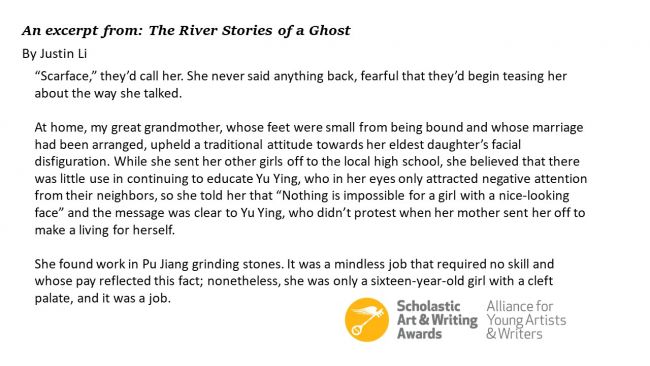This year, more than 1,700 students received national recognition in the Scholastic Art & Writing Awards, the nation’s longest running scholarship and awards program for creative teens. Among them, 16 high school seniors received the program’s highest honor: the Gold Medal Portfolio, which includes a $10,000 scholarship. Each week, we’ll highlight two of these students, one artist and one writer, to learn a little more about them, their craft, and their award-winning portfolios.
This week, we’d like to introduce you to Helena Hockertz from Surrey, British Colombia and Justin Li from Basking Ridge, NJ. Helena’s nationally recognized art portfolio, Stories To Make The World A Better Place, is a series of six short films that pay homage to some of Helena’s most-loved films and explore some of her favorite film genres. Justin’s nationally recognized writing portfolio, Shared Variations, consists of six stories that are based around the central theme of culture and are meant to confront persistent stereotypes, humanize forgotten people and ultimately challenge the reader to empathize.
What was the inspiration behind your award-winning portfolio?
Helena: My portfolio consists of 6 films that express three different genres: psychological thrillers, slapstick comedy, and experimental films. Through this portfolio, I wanted to speak to some unique aspects of human nature, but also to express the oddities of the human psyche which I found to be a rich ground to let my imagination go wild. For me, I always look at the initial inspiration as a small spark, I usually take time to develop my ideas and it's much more process-based rather than a flash of inspiration that drove me to create this portfolio.
Justin: This collection of works originates with my life experiences—particular family members, special moments, or people I’ve just met on the street. Woven into the plots of each piece, the culture of specific characters, places, and families become the main subject of the portfolio as a whole and reflect a deeper motive of confronting persistent stereotypes and humanizing forgotten people.
Through storytelling, the portfolio encourages the reader to consider alternate perspectives and gain a panoramic rather than myopic view of the world. Ultimately, it challenges them to empathize.
Do you have a favorite piece from your portfolio? If so, which one is it, and why is it your favorite?
Helena: My favorite piece in my portfolio is “From the Beginning to the End to the Beginning,” because not only did it force me to push my skills to the limit and learn much more, but there’s also a part of me that has a serious side and that wants to address urgent social issues, and climate change is one of them.
Justin: “The River Stories of a Ghost” is my favorite piece in the portfolio. It tells the story of my great-aunt’s life, who was born with a cleft palate in rural China. I will always treasure the conversations I had with my grandma at the edge of her bed, extracting all the details about her distant sister and learning so much about her own life and childhood along the way. Writing the piece also made me feel closer to my great-aunt, a relative who I didn’t even know existed for most of my life, and I found immense meaning in trying to give her the voice she’s never had.

You were able to read, or see, a piece of work from another Gold Medal recipient’s portfolio. Which piece was it and what was your impression?
Helena: Justin Li’s “The River Stories of a Ghost” is very compelling and engaging. On one level the reader is drawn into the sad and tragic life of the main character and one is deeply drawn into her story. On another level, the story piques the reader’s imagination as to the “what ifs” had the main character been able to choose a different road in life. As a filmmaker, I could see an interesting visual telling of the story where there would be two or more ways the story could be told with the main character in different parallel universes ultimately leading to the same ending of the story.
Justin: I got to watch Helena’s amazing film “Beginning to End to Beginning.” Her use of sound was so deliberate; her music choice, the static at the beginning, the tick of the clock, and the paralyzing, overlapping chatter of people speaking from the collage of TV screens really helped capture the gravity of the global warming crisis. Visually, the image of two dolls watching televisions while the globe burns beneath them was a striking representation of our reality. She says so much with so little words, and so little time. I encourage everyone to give it a watch!
If you could have dinner with one notable artist or writer, living or dead, who would it be and why?
Helena: I would like to have dinner with Edgar Wright. I love the way he blends different genres and how his creativity directs every aspect of his films, such as his choice of music and the creative transitions that comes along with it, dramatizing even the mundane activities. Most importantly, I love how he merges the boundaries between art and entertainment, and creates a truly engaging and artistic piece of work.
Justin: I’d have dinner with John Cheever. I take a lot of inspiration from his writing style. I’d ask him how his writing process begins and hope he gives me insight on making the most mundane interactions of life transcend into startling commentaries on the human condition.
What’s next for you? What are your plans for the future?
Helena: I have been accepted to New York University Tisch Film and TV program starting this coming fall. So I am looking forward to the next chapter in my learning. After that, I am not sure as I would like to take the next four years to explore different styles of filmmaking and hone my craft – but definitely, I will be pushing myself to be the best in my chosen field within the filmmaking industry.
Justin: I’d have dinner with John Cheever. I take a lot of inspiration from his writing style. I’d ask him how his writing process begins and hope he gives me insight on making the most mundane interactions of life transcend into startling commentaries on the human condition.
Cover photo: Courtesy of the Alliance for Young Artists & Writers; Writing: "The River Stories of a Ghost," Justin Li/Alliance for Young Artists & Writers; Film: "From the Beginning to the End to the Beginning," Helena Hockertz/Alliance for Young Artists & Writers



